GOING DEEPER WITH SOFTIES
By Mark Kitteridge
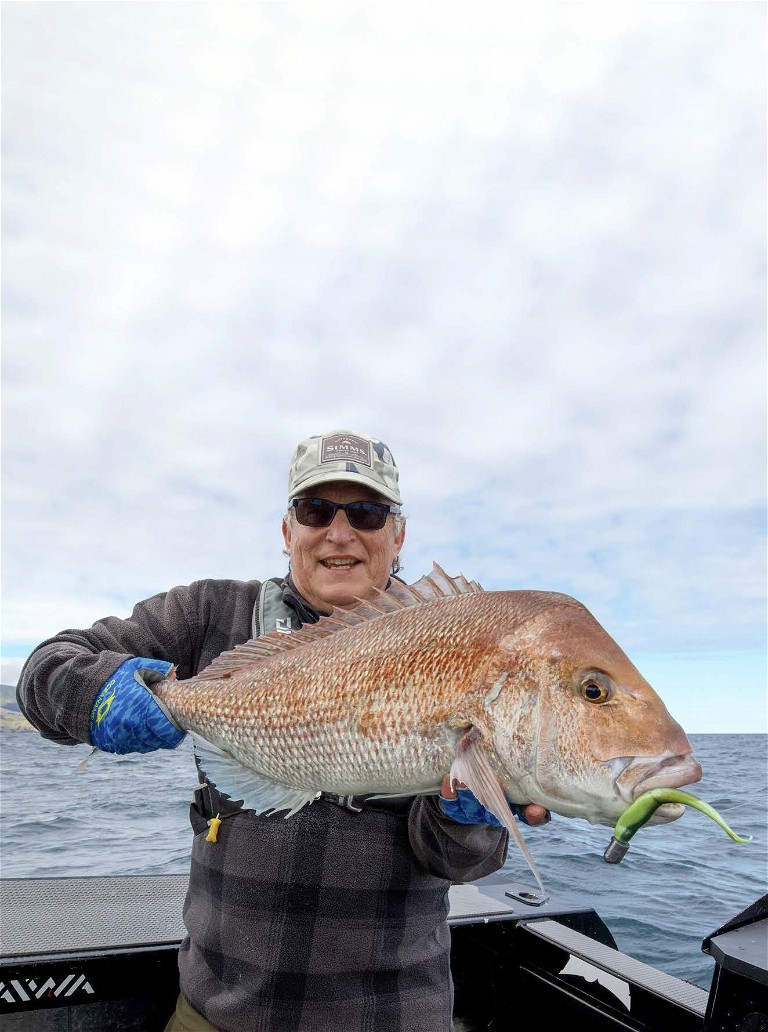
The deeper waters regularly serve up good customers, like this snapper that ate a Bait Junkie in ‘Killer Kutai’ colours.
Photo: Scott Malcon.
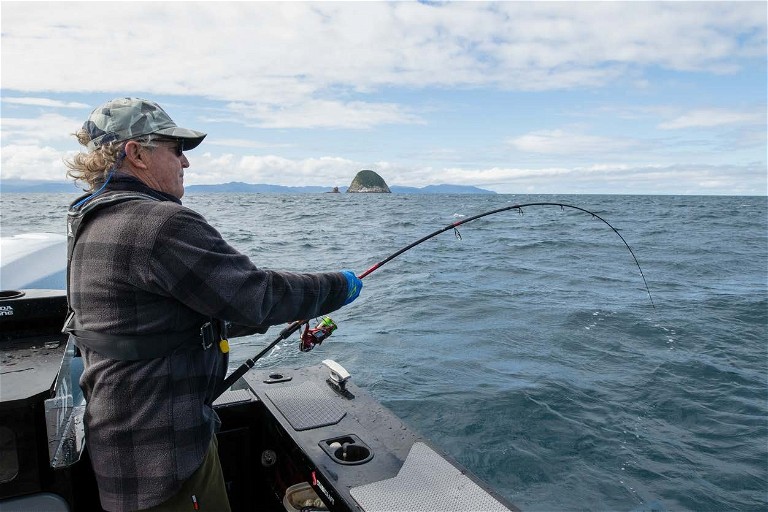
Long, powerful rods like this Daiwa Battler ‘Chilli Dog’ are perfect for casting and fishing deep waters with heavily weighted softbaits.
Photo: Scott Malcon.
Many people are surprised to learn I’m happy to use softbaits in 40-50 metres. Indeed, I’ll even fish them in depths over 70 metres if necessary – and have often done very well, too!
Sure, there are quicker ways to get down, but I regularly find that despite the slower descent times involved, the softbait gets nailed well before other heavier, more streamlined lure types attract much interest. And yes, of course, I acknowledge that this scenario can be the other way around too, but approximately two-thirds of the time softbaits in deep water come out the winner.
Recommended tackle
The rod
In this case it’s hard to beat a rod with plenty of length and power – around 8-8’6” long with 15-20lb line-weight capabilities is ideal – and I will explain why while discussing the technique later on.
The reel
The reel should ideally hold around 200-300 metres of 15-20lb braid (this typically equates to a ‘4000’ size reel these days, but there are variances between different brands’ models) and it needs to possess a smooth drag.
The line
The only practical option is braid, preferably 15-20lb, as this cuts through the water effectively, allowing even relatively light jigheads to get down. Also, thanks to its minimal stretch, good lure contact, bite detection and hooksetting capabilities are provided. Thirdly, the braid should have a high-vis colour so its movements are easier to see and then respond to quickly – a critical feature when fishing softbaits deep down.
The jig-head
Your choice of jig-head can make a massive difference between success and failure. There are four key elements for consideration: the weight; the hook size and length; how the softbait is held on; and whether it is a fixed jig-head or a ‘truck-and-trailer’ articulated type.
Although skilled anglers can often deploy a 3/4oz jig-head with success, especially in calm weather, 1oz is more common, with 1 1/2oz and even 2oz (or more) being chosen by fishos who just want to get their softbait down to the bottom with less wait time. Personally, I prefer the lighter options if possible, as despite the longer time spent getting down, the slower descent often sees the softbait nailed well up from the sea floor.
Whatever brand is chosen, it should have a good reputation. Then it’s up to the angler to decide which hook size will suit their deep-water needs best. Some associated aspects that should also be considered include:
• Essentially, we want the smallest hook that suits the size of softbait being used, as the bigger the hook the thicker its gauge tends to be, making it harder to drive home with a rod in deep water. Further, an overly big hook sees its point positioned well away from the softbait, making it less likely to be eaten along with the softbait. Unfortunately for softbaiters, a few well-known tackle brands have the bizarre notion that as the jig-head weights get heavier, the hooks must get bigger, too, despite the fact that we’re usually still fishing for the same fish with the same size softbaits!
• Conversely, of course, keep in mind that the smaller the hook is within any brand’s range, the weaker it will be, due to structural limitations when bending specific thicknesses of wire. There are some huge fish in these deeper water situations, especially around workups, so don’t take risks, particularly if your trace is 20lb or more, and be sure your knots are freshly tied.
• Hook sizes vary somewhat between the different brands, meaning that one brand’s 2/0 can be another brand’s 3/0 (or even 5/0!). I suggest comparing the potential jighead’s hook with the softbait likely to be used and seeing which one appears to suit it best. Generally though, a ‘3/0’ size fits 5-7” soft-baits nicely, and is usually strong enough to handle any size of fish encountered when using a 20-25lb leader.
• Some soft-bait brands (i.e., Z-Mans and Bait Junkies) compress very readily while others can be reasonably dense (i.e., Gulp!), so more gape and fish-holding power is created for the former after hooking up. Consequently, if the hook point is quite tight against the latter’s body, it can pay to go up one hook-size or risk it ripping out during the fight.
• The shorter the hook shank the better the tail movement, potentially attracting more strikes as a result. Bigger fish typically ‘kill’ the softbait by taking it around the upper half of its body, which is where a reasonably short-shanked 3/0 is often well placed.
Soft-bait-securing design
One of the most frustrating things when fishing softies in deep water is to wind up after a long descent and 10-15 fruitless minutes spent on the bottowm, to find the softbait has been wrenched down around the hook’s curve or ripped right off. It’s important that the softbait stays in place.

Mark finds the Berkley ‘Elevator’ articulated soft-bait jig heads very effective, especially for anglers who are dropping straight down.
As softbaits vary hugely in composition, the devices used to hold them on are also very different. For example, Gulp! products are reasonably dense, so only require quite subtle ribbing along the shank to remain in place, whereas very stretchy soft-baits such as Bait Junkie and Z-Man need large ribs or barbs to secure them. Indeed, some people even use Supa Glue to help ensure they stay where they’re supposed to!
Fixed or articulated?
I like to use a fixed ¾-1oz jig-head if possible, as these can still have suitable-sized hooks and enable me to effectively attract fish through the whole water column.
However, there are times when the conditions are choppy or perhaps all the action is happening hard against the seafloor, and when this happens the more heavily weighted 2-4oz articulated jig-heads (Berkley Elevators are excellent) definitely have their place. They are also well suited for those with shorter softbait rods or who lack the skills to cast good distances.
The lures
I generally use the larger jerk shad type lures around 7” as I want to attract a decent fish that’s worth bringing up from deep down; releasing undersized or just-legal fish in 35-70-plus metres of water is not good for them. Also, the jerk shad’s slender shape cuts through the water reasonably well, improving descent speed, the tail waggling enticingly from side-to-side in the process. However, exactly how fast or slow this aspect is can be affected by the choice of softbait brand. Want to speed things up slightly? Use Gulp! because it’s a dense material and sinks. Or, if going down slower suits the situation better, the subtly buoyant Z-Mans or Bait Junkies fit the bill better.
But don’t neglect paddle and grub-tailed softies; the vibrations they produce while moving can really ring the dinner gong, and paddle-tails in particular can be made to look incredibly realistic when lifted and dropped.
As for colour, I don’t know what the fish see deep down, although it’s a lot more than most people think. Somewhat perversely, I still like to have some luminous qualities in my choice, with the water’s clarity having some say as to whether that debatable lumo quality is combined with a reasonably natural pilchard colour or perhaps a bright pink or orange. That said, both ‘Motor Oil’ and ‘Bruised Banana’ type colours have caught their share deep down, too…
Suitable situations
While gannet and/or dolphin workups occurring in deeper waters are a gimmie, you may also be lucky enough to see some baitfish-feeding activity taking place further down, out of seabird sight, on your sounder’s screen.
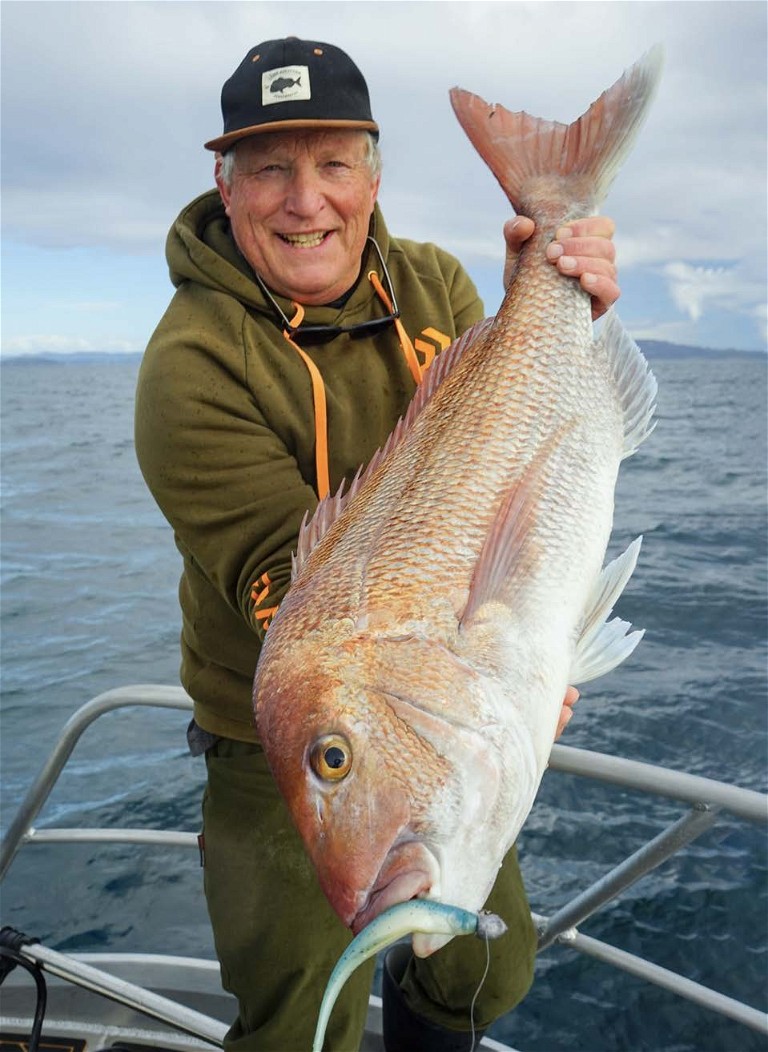
Softbaits with some lumo incorporated are favoured by Mark in deeper water.
Both are perfect for deep water soft-baiting action. However, don’t neglect any fish-sign showing near or hard against the bottom, or any reefy structure interrupting current flow, as both scenarios can be very productive, too.
The technique
If using Z-Mans or Bait Junkies, add some scent additive such as Secret Sauce or Pro Cure; the more attractive the offering, the more committed the fish will be to holding on, increasing the chances of them being hooked-up before the deception is realised. Gulp! softies need no such help, but of course they are much more fragile, too.
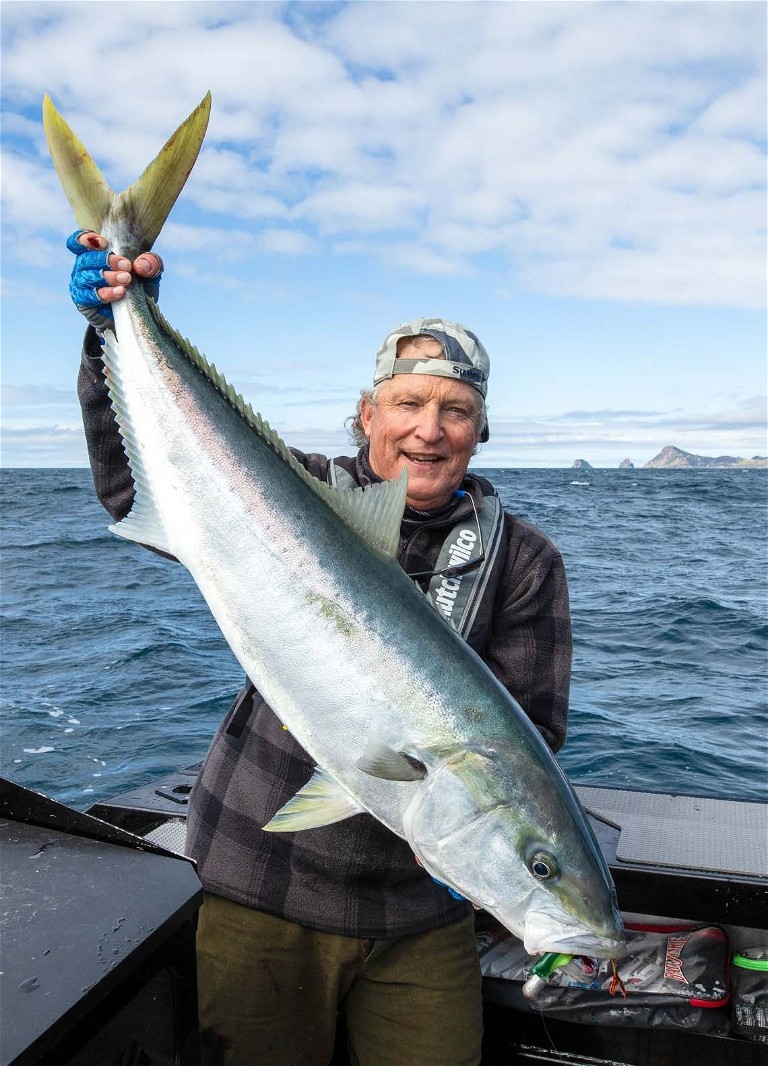
Kingfish are a common bycatch when fishing 40-70 metres.
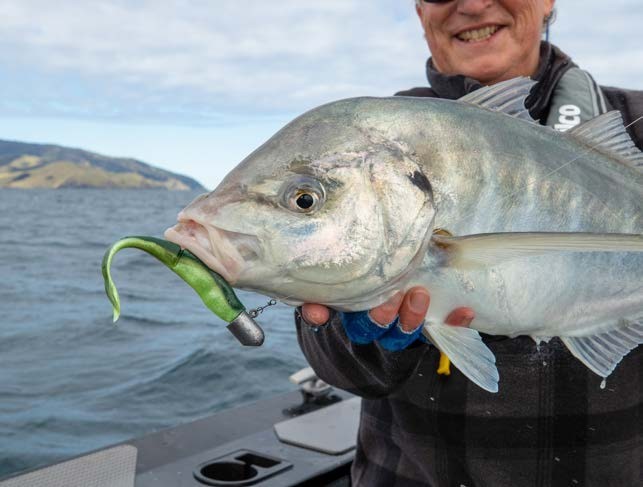
This 2oz Bait Junkie jig-head had a 7/0 hook fitted but still accounted for some excellent fish like this trevally.
Photo: Scott Malcon.
Cast the softbait as far as possible up ahead of the boat’s drift direction. This is where that long 8-8.5’ rod comes in handy, as the longer the cast, the less line that must be added afterwards, enabling better line control. If the wind is conflicting with the current’s direction, there’s a good chance that the lure will be swept well away from the boat. If so, adjust the casting direction so the lure ends up angling back towards the boat instead, ideally sliding down alongside the boat and perhaps out the back eventually.
Introduce some extra rod lengths of slack line (the exact number required depends on how far you can cast and the water’s depth below) in front of you so the lure is able to descend as freely as possible for most of its fall. Watch where that slack braid enters the surface like a hawk – if it starts motoring off at high speed, wind in frantically and strike hard, as this usually means a very big, aggressive fish!
Otherwise, when the line is nearly all removed from the surface, it’s choice time:
If the sinking line still extends nicely ahead of the boat and you believe the lure is not far from the seafloor, allow the line to tighten so the lure is slowed and forced to arc downwards instead. Point the rod down along the line and watch the line’s behaviour closely; if it jerks, slackens or tightens, wind quickly until the pressure comes on, then lift the rod firmly to hook up.
If the lure’s descent position is unlikely to be near the productive bottom area, wait until the line is almost gone, then whip one rod length of extra line off and point the rod back down again, ready for action. Should the line continue to steadily sink and tighten, keep repeating the single rod whips until the line pauses or changes behaviour. When this happens, wind quickly, in case it’s a fish, and if it is, strike when the pressure comes on.
But maybe it was just the bottom registering, and the line is now reasonably vertical below. If so, try mixing things up a bit. Long rods are great for doing slow, jiggling uplifts, followed by slack drops, the rod following the slightly slack line downwards. Again, be alert for any bites and respond with a quick wind, to force them to commit, before striking. Or, my favourite, a slowmotion mechanical-jig action. This consists of a lift and drop of the rod while simultaneously making one turn of the reel handle – just repeat this motion up to five or six times, then allow the softbait to drop back down again. Although the fish will often strike on the way up, most times the only indication is that the line takes too long to sink – quick, wind to tighten up, then strike… hooked up again!